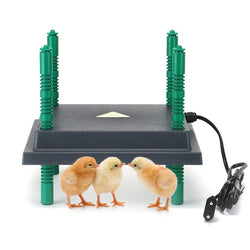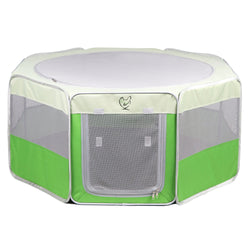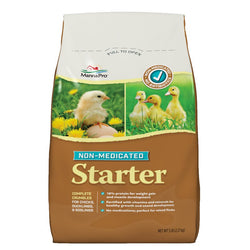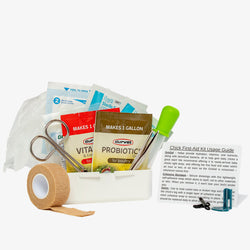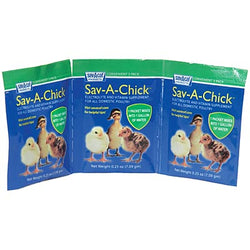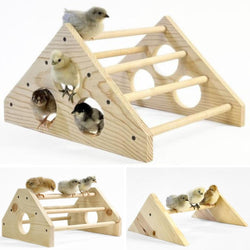All about VVD disease
Back to blog
VVD disease produces twisted leg bones due to nutritional deficiencies or overly-fast weight gain in "broiler" breeds. Thankfully this is rare in backyard flocks that are fed a balanced, nutritionally complete diet, but it is more common in commercial broiler flocks. Read on to find out more:
VVD Also called
Varus/Valgus Deformity, Twisted leg, Crooked leg
Prevalence
Rare in home flocks; common in commercial "broilers"
Signs
General signs -
Leg bone is bent or twisted (not broken).
Cardinal or diagnostic signs -
Be sure to differentiate this from a leg that is twisted at the joint; in VVD, the bone itself is bent.

Rhode Island Red with VVD. Picture credit: Briana, California
Cause/s
This is common is factory farm broilers, where the bird's fast weight gain may outstrip what the skeleton can bear. It can also be caused from nutritional deficiencies in young chicks or pullets. For instance, a lack of B vitamins, calcium, or vitamin D can cause the skeleton to be soft.
Communicability
Not passed from bird to bird, but if your flock is eating the same diet, several might suffer. Some breeds are more prone than others. It's common in Rock Cornish crosses (meat birds). Among layers, leghorns are more prone.
Communicability to humans
No.
Incubation period
No incubation period. This is a deformity that can develop from a number of causes.
Latent
No.
Endemic
Not a communicable disease.
Home treatment and/or prevention
Prevention: Be sure to offer a balanced feed to your birds, and don't feed too many treats, which can upset the nutritional balance. Allow your birds into areas of natural sunlight so they will have enough vitamin D. Medicated chick feeds with Amprol, designed to help protect against coccidiosis, work by "starving" the cocci of B vitamins. We don't know of any studies that have shown this can increase the chance of VVD, but it won't hurt to exercise caution. If you choose to use medicated feed, be sure to keep your birds on the medication no longer than the feed manufacturer recommends for their formulation.
Treatment: None. This is a skeletal deformity. However, if you notice this developing in your flock, be sure to check their diet, which may help halt the deformity from developing further.
Veterinary care
Your vet may be able to provide you with insight into what the nutritional problem may be or make feed/supplement recommendations.
Recovery
Typically, no. As the bone itself is deformed, there is not a way to correct it, unless surgically, even then, I doubt there are many vets with the surgical experience to correct developmental bone deformities in chickens. In many cases, the chicken can still live a relatively normal life, even with some lameness.
Other conditions, illnesses and/or diseases with similar signs:
Marek's Disease and botulism can cause leg paralysis. A slipped tendon can give the appearance of a deformity.
Also consider browsing through this list of other chicken illnesses with neurological symptoms.
VVD Also called
Varus/Valgus Deformity, Twisted leg, Crooked leg
Prevalence
Rare in home flocks; common in commercial "broilers"
Signs
General signs -
Leg bone is bent or twisted (not broken).
Cardinal or diagnostic signs -
Be sure to differentiate this from a leg that is twisted at the joint; in VVD, the bone itself is bent.

Rhode Island Red with VVD. Picture credit: Briana, California
Cause/s
This is common is factory farm broilers, where the bird's fast weight gain may outstrip what the skeleton can bear. It can also be caused from nutritional deficiencies in young chicks or pullets. For instance, a lack of B vitamins, calcium, or vitamin D can cause the skeleton to be soft.
Communicability
Not passed from bird to bird, but if your flock is eating the same diet, several might suffer. Some breeds are more prone than others. It's common in Rock Cornish crosses (meat birds). Among layers, leghorns are more prone.
Communicability to humans
No.
Incubation period
No incubation period. This is a deformity that can develop from a number of causes.
Latent
No.
Endemic
Not a communicable disease.
Home treatment and/or prevention
Prevention: Be sure to offer a balanced feed to your birds, and don't feed too many treats, which can upset the nutritional balance. Allow your birds into areas of natural sunlight so they will have enough vitamin D. Medicated chick feeds with Amprol, designed to help protect against coccidiosis, work by "starving" the cocci of B vitamins. We don't know of any studies that have shown this can increase the chance of VVD, but it won't hurt to exercise caution. If you choose to use medicated feed, be sure to keep your birds on the medication no longer than the feed manufacturer recommends for their formulation.
Treatment: None. This is a skeletal deformity. However, if you notice this developing in your flock, be sure to check their diet, which may help halt the deformity from developing further.
Veterinary care
Your vet may be able to provide you with insight into what the nutritional problem may be or make feed/supplement recommendations.
Recovery
Typically, no. As the bone itself is deformed, there is not a way to correct it, unless surgically, even then, I doubt there are many vets with the surgical experience to correct developmental bone deformities in chickens. In many cases, the chicken can still live a relatively normal life, even with some lameness.
Other conditions, illnesses and/or diseases with similar signs:
Marek's Disease and botulism can cause leg paralysis. A slipped tendon can give the appearance of a deformity.
Also consider browsing through this list of other chicken illnesses with neurological symptoms.




